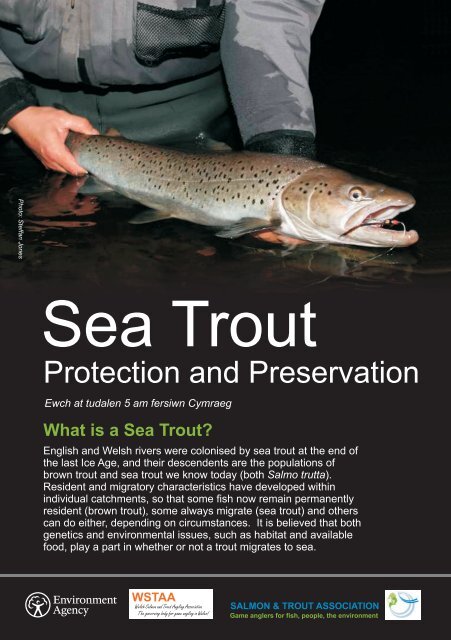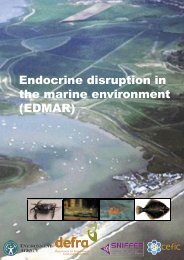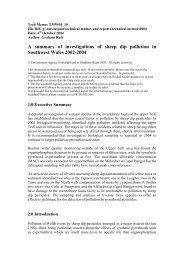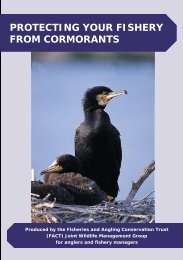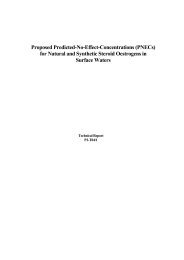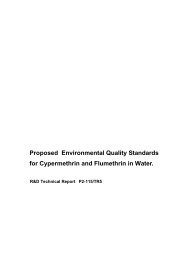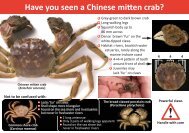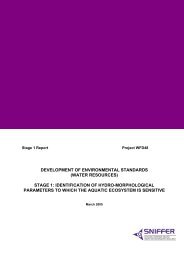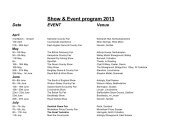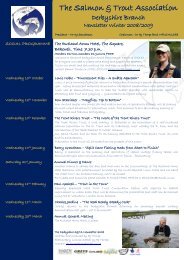What is a Sea Trout? - Salmon & Trout Association
What is a Sea Trout? - Salmon & Trout Association
What is a Sea Trout? - Salmon & Trout Association
Create successful ePaper yourself
Turn your PDF publications into a flip-book with our unique Google optimized e-Paper software.
Photo: Steffan Jones<br />
<strong>Sea</strong> <strong>Trout</strong><br />
Protection and Preservation<br />
Ewch at tudalen 5 am fersiwn Cymraeg<br />
<strong>What</strong> <strong>is</strong> a <strong>Sea</strong> <strong>Trout</strong><br />
Engl<strong>is</strong>h and Welsh rivers were colon<strong>is</strong>ed by sea trout at the end of<br />
the last Ice Age, and their descendents are the populations of<br />
brown trout and sea trout we know today (both Salmo trutta).<br />
Resident and migratory character<strong>is</strong>tics have developed within<br />
individual catchments, so that some f<strong>is</strong>h now remain permanently<br />
resident (brown trout), some always migrate (sea trout) and others<br />
can do either, depending on circumstances. It <strong>is</strong> believed that both<br />
genetics and environmental <strong>is</strong>sues, such as habitat and available<br />
food, play a part in whether or not a trout migrates to sea.<br />
WSTAA<br />
Welsh <strong>Salmon</strong> and <strong>Trout</strong> Angling <strong>Association</strong><br />
The governing body for game angling in Wales!<br />
SALMON & TROUT ASSOCIATION<br />
Game anglers for f<strong>is</strong>h, people, the environment
Why do <strong>Sea</strong> <strong>Trout</strong> require Protection<br />
At the 1st International <strong>Sea</strong> <strong>Trout</strong> Symposium at Cardiff University in July 2004, four<br />
key <strong>is</strong>sues emerged as being vital to the future of our sea trout stocks:<br />
l<strong>Sea</strong> trout util<strong>is</strong>e tiny spawning streams, but these are the very habitats most<br />
at threat from unsympathetic land use and agriculture.<br />
lFinn<strong>is</strong>h sea trout stocks have been savaged by f<strong>is</strong>h being accidentally<br />
caught in the coastal white f<strong>is</strong>h gill-net f<strong>is</strong>hery. The UK's coastal waters are<br />
exploited by bass gill-netters, and the potential threat to sea trout <strong>is</strong> obvious.<br />
lLarger female sea trout are often multiple repeat spawners with a potential to<br />
deposit many eggs over their lifetime, so maxim<strong>is</strong>ing their contribution to<br />
local stocks. They have proven their fitness to survive in both the river and<br />
the sea and so contain important genes to pass on to their progeny.<br />
Protection of larger f<strong>is</strong>h <strong>is</strong> therefore vital.<br />
lSome scientific opinion suggests that salmon are on the edge of their viable<br />
range in the southern half of England and Wales. If our climate becomes<br />
warmer, as <strong>is</strong> widely predicted through global warming, sea trout will also be<br />
vulnerable to the resulting environmental pressures, such as droughts,<br />
abnormal winter flows, inevitable changes to their growth/life h<strong>is</strong>tory and,<br />
weakened by sub-lethal levels of pollution while in rivers, they might be<br />
unable to survive the additional stress of migrating from freshwater into the<br />
marine environment.<br />
<strong>What</strong> can you do to help<br />
2<br />
lPolicies to protect spawning habitat and the control of coastal netting are<br />
matters best dealt with at national level by influencing leg<strong>is</strong>lation and<br />
byelaws. Joining a national organ<strong>is</strong>ation <strong>is</strong> an excellent way of helping th<strong>is</strong><br />
work (see organ<strong>is</strong>ations on page 4).<br />
lLocally, you can help by supporting the work of Rivers Trusts - contact the<br />
<strong>Association</strong> of Rivers Trusts or Afonydd Cymru for further information.<br />
lAnglers can help conserve sea trout stocks by showing restraint in the<br />
number of f<strong>is</strong>h they kill. A 'large' sea trout will vary from river to river but as<br />
a rule, we believe that all f<strong>is</strong>h over 5 lbs are best released unharmed to the<br />
water, and th<strong>is</strong> size limit should be reduced in areas where smaller sea trout<br />
are the norm.<br />
lFinally, if you see a pollution incident, or anything else which you feel could<br />
be detrimental to f<strong>is</strong>h stocks in rivers or lakes, contact the Environment<br />
Agency Emergency number: 0800 807060
Photo: Dave Mee<br />
Sporting Value<br />
<strong>Sea</strong> trout are superb sporting f<strong>is</strong>h, highly<br />
prized by game anglers throughout<br />
England and Wales. Whereas many<br />
rivers have seen a decline in salmon<br />
runs, sea trout populations have generally<br />
fared rather better and, in several areas,<br />
their value to anglers and the local<br />
economy now exceeds that of salmon.<br />
However, warning signs have recently<br />
appeared which suggest that sea trout<br />
are also under pressure. Therefore,<br />
protective measures taken now might<br />
avert a future collapse in stocks.<br />
Photo: Moc Morgan<br />
How do you safely release a <strong>Sea</strong> <strong>Trout</strong><br />
Most importantly, use single, barbless hooks and as strong a tippet as feasible. Play<br />
the sea trout quickly and, wherever possible, net the f<strong>is</strong>h in water deep enough to<br />
avoid contact with river bed or bank. Handle the f<strong>is</strong>h sparingly (th<strong>is</strong> <strong>is</strong> where barbless<br />
hooks will greatly ass<strong>is</strong>t), using tweezers or pliers to remove the hook, and then<br />
release from the net. However, where a sea trout has been played to exhaustion, it<br />
will be necessary to carefully hold the f<strong>is</strong>h facing the current until it regains sufficient<br />
strength to swim away from the hand. Take extra care during the summer months<br />
when water temperatures are high and f<strong>is</strong>h can take longer to recover.<br />
Habitat<br />
improvement<br />
Th<strong>is</strong> example shows<br />
how the creation of<br />
buffer zones reduces<br />
impact from farm stock<br />
and quickly returns a<br />
stretch of river to a<br />
more natural state.<br />
3
Don't forget to report your catch!<br />
Catch stat<strong>is</strong>tics are a vital tool in determining the local and national trends in sea<br />
trout populations. Don't forget to fill in the returns (for both killed and returned<br />
f<strong>is</strong>h) on the back of your Environment Agency Migratory F<strong>is</strong>h Licence and send<br />
back to the address supplied. Th<strong>is</strong> should also include nil returns, as f<strong>is</strong>hing effort<br />
plays an important part in the Environment Agency's current methodology for sea<br />
trout stock assessment, as it <strong>is</strong> based on trends in catch per licence day.<br />
Based on the latest available rod catch and effort data, all rivers would benefit<br />
from increased catch and release of sea trout, although those under particular<br />
pressure include:<br />
South West: Otter, Dart, Fowey, Torridge, Camel<br />
North West: Ribble, Lune, Cumbrian Esk, Derwent, Border Esk, Eden<br />
Wales: Tawe, Teifi, Dwyfawr, Tywi, Ogmore, Loughor, Ogwen<br />
Research<br />
Finally, several sea trout projects are now underway, including the Celtic <strong>Sea</strong><br />
<strong>Trout</strong> Project (www.celticseatrout.com). Some of these may require anglers to<br />
contribute scale samples and, although th<strong>is</strong> will be on a voluntary bas<strong>is</strong>, your<br />
ass<strong>is</strong>tance wherever possible would be greatly appreciated.<br />
Further information<br />
<strong>Salmon</strong> & <strong>Trout</strong> <strong>Association</strong><br />
www.salmon-trout.org<br />
Welsh <strong>Salmon</strong> and <strong>Trout</strong> Angling <strong>Association</strong> www.wstaa.org<br />
Environment Agency<br />
www.environment-agency.gov.uk<br />
<strong>Association</strong> of Rivers Trusts<br />
www.associationofriverstrusts.org.uk<br />
Afonydd Cymru<br />
www.afonyddcymru.org<br />
4
Ffoto: Steffan Jones<br />
Sewin<br />
eu hamddiffyn a'u cadw<br />
Beth yw Sewin<br />
Daeth sewin i afonydd Cymru a Lloegr ddiwedd yr Oes Iâ<br />
ddiwethaf, a'u d<strong>is</strong>gynyddion hwy yw'r brithyllod sydd mor<br />
gyfarwydd i ni heddiw. Mae rhai'n aros yn eu dalgylch yn barhaol<br />
(brithyllod afon), rhai wastad yn ymfudo i'r môr (sewin), a gall eraill<br />
ymfudo neu beidio, yn ôl yr angen: ond yr un rhywogaeth, Salmo<br />
trutta, ydynt. Credir fod a wnelo etifeddeg a'r amgylchedd (natur y<br />
cynefin a faint o fwyd sydd ar gael) â phenderfynu a yw brithyll yn<br />
ymfudo i'r môr ai peidio.<br />
WSTAA<br />
Welsh <strong>Salmon</strong> and <strong>Trout</strong> Angling <strong>Association</strong><br />
The governing body for game angling in Wales!<br />
SALMON & TROUT ASSOCIATION<br />
Game anglers for f<strong>is</strong>h, people, the environment<br />
5
Pam mae angen amddifyn sewin<br />
Yn y Gynhadledd Brithyllod Morol Ryngwladol gyntaf ym Mhrifysgol Caerdydd yng<br />
Ngorffennaf 2004, penderfynwyd fod pedwar pwnc yn hanfodol ar gyfer dyfodol<br />
stociau sewin:<br />
lMae sewin yn defnyddio nentydd silio bychain bach, ond dyma'r union<br />
gynefinoedd a fygythir mwyaf gan ddihidrwydd defnyddwyr tir a chan amaeth.<br />
lMae stociau sewin y Ffindir wedi dioddef yn ofnadwy oherwydd eu dal yn<br />
rhwydi tagell pysgodfa pysgod gwynion y glannau. Gosodir rhwydi tagell ar<br />
gyfer draenogiaid hyd lannau'r DU, ac y mae bygythiad hynny i sewin yn<br />
amlwg.<br />
lDichon i sewin benywaidd mwy silio sawl gwaith, bwrw llawer o wyau yn<br />
ystod eu hoes, a chyfrannu'n helaeth at stociau lleol. Wedi dangos y gallant<br />
oroesi yn nŵr hallt neu groyw, mae'n bwysig eu bod nhw'n trosglwyddo'u<br />
genynnau i'w hepil. Felly rhaid amddiffyn pysgod mwy.<br />
lYm marn rhai gwyddonwyr, mae eogiaid ar ymyl eithaf eu tiriogaeth yn<br />
hanner deheuol Cymru a Lloegr. Os bydd ein hinsawdd ni'n cynhesu, fel y<br />
rhagwelir oherwydd cynhesu byd-eang, bydd sewin hefyd yn agored i'r<br />
pwysau amgylcheddol canlyniadol, meg<strong>is</strong> sychderau, llifoedd annormal yn y<br />
gaeaf, a newidiadau anorfod yn eu twf a'u cylchedd bywyd. Gyda digon o<br />
lygredd yn afonydd i'w gwanhau (os nad eu lladd), efallai na fydd modd<br />
iddynt oroesi straen ychwanegol ymfudo o ddŵr croyw i ddŵr hallt.<br />
Beth allwch chi'i wneud i helpu<br />
lGorau delio â phol<strong>is</strong>ïau amddiffyn cynefin silio a rheoli rhwydo hyd y<br />
glannau ar raddfa genedlaethol, trwy ddylanwadu ar ddeddfwriaeth ac <strong>is</strong>ddeddfau.<br />
Mae ymuno â chorff cenedlaethol yn ffordd wych o helpu'r gwaith<br />
hwn (gweler cymdeithasau ar tudalen 8).<br />
lYn lleol, gallwch helpu trwy gefnogi gwaith Ymddiriedolaethau Afon.<br />
Cysylltwch â'r Gymdeithas Ymddiriedolaethau Afon neu ag Afonydd Cymru<br />
am ragor o wybodaeth.<br />
lGall genweirwyr helpu cadw stociau sewin trwy beidio â lladd cymaint o<br />
bysgod. Gall maint sewin “mawr” amrywio o afon i afon, ond yn gyffredinol<br />
credwn mai gorau rhyddhau pob pysgodyn rhagor na 5 pwys yn ôl i'r dŵr,<br />
heb ei niweidio: ac y dylid lleihau'r cyfyngiad maint hwn lle bo sewin yn llai,<br />
fel arfer.<br />
6<br />
lI gloi, os gwelwch lygredd neu unrhyw beth arall y teimlwch y gallai niweidio<br />
stociau pysgod afonydd neu lynnoedd, galwch rif argyfwng Asiantaeth yr<br />
Amgylchedd: 0800 807060.
Ffoto: Dave Mee<br />
Gwerth sbort<br />
Mae hwyl garw ar ddal sewin, a<br />
genweirwyr gêm Cymru gyfan wrth eu<br />
boddau â hwy. Er y bu lleihad yn<br />
niferoedd eogiaid, mae gwell llewyrch ar<br />
sewin: ac yn sawl man, maent yn fwy<br />
gwerthfawr nag eogiaid i enweirwyr a'r<br />
economi lleol. Yn ddiweddar, fodd<br />
bynnag, mae arwyddion yn awgrymu fod<br />
y sewin hwythau o dan bwysau. Gallai eu<br />
hamddiffyn heddiw osgoi difetha'r stociau<br />
yn y dyfodol.<br />
Ffoto: Moc Morgan<br />
Sut mae rhyddhau sewin yn ddiogel<br />
Yn bwysicaf oll, defnyddiwch fachau sengl, diadfach gyda blaen lein cyn gryfed ag y<br />
bo modd. Chwaraewch y sewin cyn gyflymed ag y gallwch, a rhwydwch ef yn nŵr<br />
digon dwfn i osgoi cyffwrdd â gwaelod neu lan yr afon. Trafodwch y pysgodyn cyn<br />
lleied ag y bo modd (dyma lle mae bachau diadfach o gymorth mawr), gan ddefnyddio<br />
gefail i dynnu'r bachyn: yna rhyddhewch y pysgodyn o'r rhwyd. Os yw'r sewin wedi'i<br />
flino'n llwyr gan y chwarae, daliwch ef, yn ofalus, â'i geg yn wynebu'r llif hyd nes y daw<br />
ato'i hun ddigon i nofio ymaith. Byddwch yn arbennig o ofalus yn ystod yr haf: bydd y<br />
dŵr yn gynhesach, a gall y bydd ar bysgod angen rhagor o amser i ddadflino.<br />
Gwella cynefin<br />
Dyma enghraifft o sut y<br />
mae creu lleiniau<br />
clustogi'n lleihau effaith<br />
da byw, a'r afon o<br />
ganlyniad yn<br />
dychwelyd i gyflwr mwy<br />
naturiol.<br />
7
Peidiwch ag anghofio rhoi gwybod am eich<br />
daliad chi!<br />
Mae ystadegau daliadau'n hanfodol ar gyfer gweld tueddiadau lleol a<br />
chenedlaethol poblogaethau sewin. Peidiwch ag anghofio llenwi'r ffurflenni<br />
(pysgod a laddwyd neu a ddychwelwyd) ar gefn eich Trwydded Pysgod Mudol<br />
Asiantaeth yr Amgylchedd chi, a'u gyrru at y cyfeiriad priodol. Dylai hynny<br />
gynnwys adegau pan ni ddaliwyd pysgod, gan fod ymdrech bysgota'n rhan<br />
bwysig o fethodoleg bresennol Asiantaeth yr Amgylchedd ar gyfer asesu'r stoc<br />
sewin, oherwydd fe'i seilir ar dueddiadau daliadau pob diwrnod trwydded unigol.<br />
Ar sail yr wybodaeth daliadau ac ymdrech genweiriau ddiweddaraf sydd ar gael,<br />
byddai cynyddu dal a rhyddhau o les i bob afon: ond y rhai sydd fwyaf tan<br />
bwysau yw:<br />
Cymru:<br />
Tawe, Teifi, Dwyfor, Tywi, Ogwr, Llwchwr, Ogwen<br />
De-orllewin Lloegr:<br />
Gogledd-ddwyrain Lloegr:<br />
Ymchwil<br />
Rhagor o wybodaeth<br />
Otter, Dart, Fowey, Torridge, Camel<br />
Ribble, Lune, Esk Cumbria, Derwennydd,<br />
Esk y Goror, Idon<br />
I gloi, mae sawl cynllun sewin ar gerdded, gan gynnwys Cynllun Sewin Celtaidd<br />
(www.celticseatrout.com). Efallai y bydd rhai ohonynt yn gofyn i enweirwyr yrru<br />
samplau cen. Bydd hynny'n wirfoddol, ond os oes modd i chi ein helpu ni,<br />
gwerthfawrogir eich cymorth chi'n fawr.<br />
Y Gymdeithas Eogiaid a Brithyllod - www.salmon-trout.org<br />
Cymdeithas Genweirio Eogiaid a Brithyllod Cymru - www.wstaa.org<br />
Asiantaeth yr Amgylchedd Cymru - www.asiantaeth-amgylchedd.cymru.gov.uk<br />
Y Gymdeithas Ymddiriedolaethau Afon - www.associationofrivertrusts.org.uk<br />
Afonydd Cymru - www.afonyddcymru.org<br />
8


